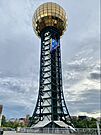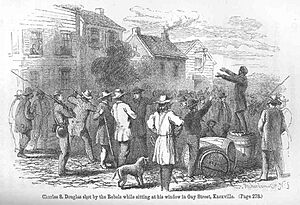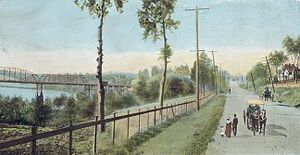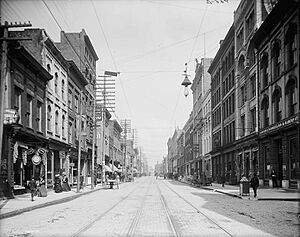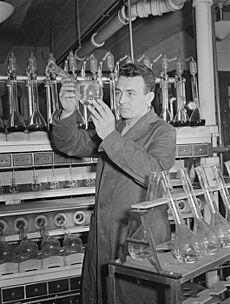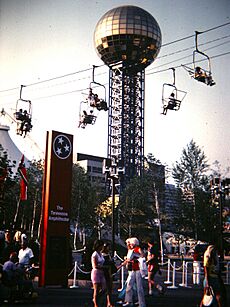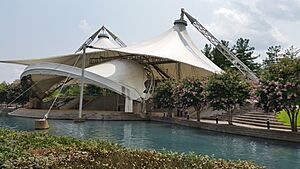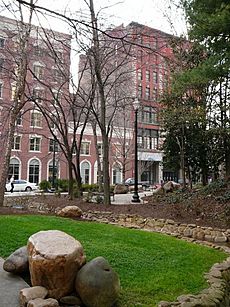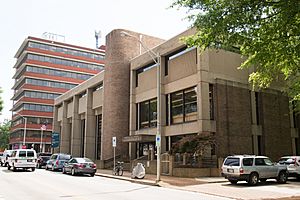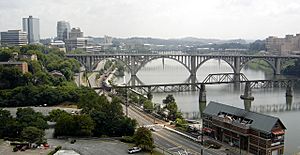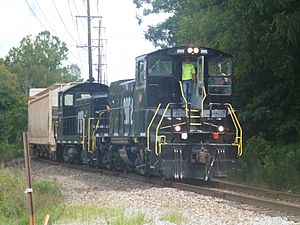Knoxville, Tennessee facts for kids
Quick facts for kids
Knoxville
|
|||||
|---|---|---|---|---|---|
|
Skyline of Downtown Knoxville
Neyland Stadium
The Sunsphere at the World's Fair Park
Clock tower on Gay Street
A statue in the Old Gray Cemetery
Ayres Hall at UT Knoxville
Tennessee Amphitheater
|
|||||
|
|||||
| Nickname(s):
Marble City, Heart of the Valley, Queen City of the Mountains, K-Town, Scruffy City, Gateway to the Great Smoky Mountains, Knox Vegas.
|
|||||

Location of Knoxville in Knox County, Tennessee.
|
|||||
| Country | United States | ||||
| State | Tennessee | ||||
| County | Knox | ||||
| Settled | 1786 | ||||
| Founded | 1791 | ||||
| Incorporated | 1815 | ||||
| Founded by | James White | ||||
| Named for | Henry Knox | ||||
| Government | |||||
| • Type | Mayor–council | ||||
| Area | |||||
| • City | 104.25 sq mi (270.01 km2) | ||||
| • Land | 98.73 sq mi (255.72 km2) | ||||
| • Water | 5.52 sq mi (14.30 km2) 5.4% | ||||
| Elevation | 886 ft (270 m) | ||||
| Population
(2020)
|
|||||
| • City | 190,740 | ||||
| • Rank | US: 127th TN: 3rd |
||||
| • Density | 1,931.90/sq mi (745.91/km2) | ||||
| • Urban | 597,257 (US: 72nd) | ||||
| • Urban density | 1,382.8/sq mi (533.9/km2) | ||||
| • Metro | 868,546 (US: 64th) | ||||
| • CSA | 1,096,961 (US: 50th) | ||||
| Demonym(s) | Knoxvillian | ||||
| Time zone | UTC−5 (EST) | ||||
| • Summer (DST) | UTC−4 (EDT) | ||||
| Zip code |
37901-37902, 37909, 37912, 37914-37920-37924, 37927-37934, 37938-37940, 37950, 37995-37998
|
||||
| Area code(s) | 865 | ||||
| FIPS code | 47-40000 | ||||
| GNIS feature ID | 1648562 | ||||
Knoxville is a city in Tennessee, United States. It is the main city of Knox County. Knoxville is located on the Tennessee River. In 2020, about 190,740 people lived there. This makes it the third-largest city in Tennessee. Only Nashville and Memphis are larger. Knoxville is also the biggest city in East Tennessee.
The city was first settled in 1786. It was the first capital of Tennessee. For many years, it was hard for Knoxville to connect with other places. But when the railroad arrived in 1855, the city's economy grew a lot. During the American Civil War, people in Knoxville had very different ideas about joining the Confederacy. Both Confederate and Union armies took control of the city at different times. A big battle, the Battle of Fort Sanders, happened here in 1863.
After the war, Knoxville became a major center for selling and making goods. However, after the 1920s, the city's economy slowed down. This was because factories closed, and the downtown area became less active. Hosting the 1982 World's Fair helped bring new energy to the city. Since then, leaders and developers have worked to make Knoxville grow again, especially in the downtown area.
Knoxville is home to the main campus of the University of Tennessee. Their sports teams, the Tennessee Volunteers, are very popular. The city also hosts the main office of the Tennessee Valley Authority. This is a large government agency that provides power. Knoxville is seen as an important place for Appalachian culture. It is also a main entrance to the Great Smoky Mountains National Park.
Contents
Exploring Knoxville's Past
Early Days and Native Americans
The first people to live in the Knoxville area were Native Americans. They arrived around 1000 B.C. One of the oldest structures is a burial mound built by the Mississippian culture. This mound is now part of the University of Tennessee campus.
By the 1700s, the Cherokee people were the main tribe here. They called the area kuwanda'talun'yi, which means "mulberry place". The Cherokee often fought with the Creek and Shawnee tribes.
European explorers first came to the Tennessee Valley in the late 1600s. There is a lot of evidence that Spanish explorer Hernando de Soto visited the area in 1540. In 1761, the Timberlake Expedition explored the rivers near Knoxville.
How Knoxville Was Founded
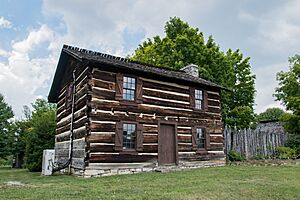
After the French and Indian War and the American Revolutionary War, more white settlers moved west. By the 1780s, they were living in the Holston and French Broad valleys. This caused problems with the Cherokee.
In 1786, James White, a Revolutionary War officer, built James White's Fort. This fort was near First Creek. In 1790, White's son-in-law, Charles McClung, planned out the town. He set aside land for a church, a graveyard, and a school. This school later became the University of Tennessee.
In 1790, George Washington made William Blount governor of the new Territory South of the River Ohio. Blount signed a treaty with the Cherokee in 1791 at White's Fort. This was called the Treaty of Holston. Blount named the new capital Knoxville after General Henry Knox. Knox was the Secretary of War at the time.
There were still problems with the treaty. In 1793, Knoxville settlers attacked the Cherokee during peace talks. They killed the chief's wife. Peace was finally made in 1794.
Knoxville Before the Civil War
Knoxville was the capital of Tennessee until 1817. Early Knoxville was a busy river town. The first newspaper in Tennessee, Knoxville Gazette, was printed here. It reported on daily life, including crimes and conflicts with the Cherokee.
Knoxville grew as a stop for people traveling west. Its location on three major rivers brought boat traffic. It became a center for trade. Farmers traded local products like tobacco and corn for cotton from the South. The city's population doubled in the 1850s when the railroad arrived in 1855.
A famous person from this time was Hugh Lawson White. He was James White's son. He served as a judge and senator. In 1836, he ran for president but did not win.
Knoxville During the Civil War
Many people in East Tennessee were against slavery and leaving the Union. William "Parson" Brownlow, a newspaper publisher, was a strong supporter of the Union. However, businesses in Knoxville had strong ties to the South. This led to many people in the city supporting the Confederacy.
In 1861, East Tennessee voted against leaving the Union. But Knoxville itself voted to join the Confederacy. Union supporters met in Knoxville and tried to keep Tennessee in the Union. After Tennessee seceded, they tried to create a separate Union state in East Tennessee.
In July 1861, General Felix Zollicoffer of the Confederacy took control of Knoxville. He declared martial law in November after Union supporters burned seven city bridges. In 1863, General Simon Bolivar Buckner fortified Knoxville. But he had to leave when stronger Union forces arrived.
Union General Ambrose Burnside arrived in September 1863. He also began to fortify the city. He built many forts around Knoxville, including Fort Sanders. On November 29, Confederate General James Longstreet attacked Fort Sanders. But the Union soldiers successfully defended it. Longstreet ended his siege on December 4. This Union victory helped the Union control East Tennessee for the rest of the war.
Growth After the War
After the Civil War, Knoxville recovered quickly. Investors from the North helped. The Richards brothers brought Welsh families to work in factories. These families settled in an area called Mechanicsville. The Richards brothers also started the Knoxville Iron Works. This site later hosted the 1982 World's Fair.
Many new companies started, like Knoxville Woolen Mills. By the 1890s, Knoxville was a major trading center in the South. The Candoro Marble Works became famous for its pink marble. In 1896, Knoxville created its own flag to celebrate its growth.
The University of Tennessee also grew after the war. Its name changed from East Tennessee University in 1879. Thousands of immigrants moved to the city, and the population grew a lot.
Modern Knoxville and the World's Fair
Knoxville hosted the Appalachian Exposition in 1910 and 1911. It also hosted the National Conservation Exposition in 1913. This event helped start the idea for a national park in the Great Smoky Mountains. Local businessman Colonel David C. Chapman helped raise money for the park. The Great Smoky Mountains National Park opened in 1933.
The Great Depression hit Knoxville hard. The Tennessee Valley Authority (TVA) was created in 1933 to help the region. TVA built dams to control floods and provide electricity. This brought jobs and power to the area. The Works Progress Administration helped build McGhee Tyson Airport and expand Neyland Stadium.
In 1947, a writer called Knoxville the "ugliest city" in America. This made the city work to improve its appearance.
Knoxville's factories faced problems in the 1950s and 1960s. The city tried to grow by adding nearby communities. In 1962, Knoxville added Bearden and Fountain City. But attempts to add other areas, like Farragut, failed.
To boost its economy, Knoxville hosted the 1982 World's Fair. This event brought eleven million visitors. The Rubik's Cube was first shown here. The Sunsphere, a tall golden tower, was built for the fair. It is still a famous landmark today, along with the Tennessee Amphitheater.
In the 1980s and 1990s, Knoxville grew its city limits. This was done to increase tax money. However, some residents were against this growth.
Knoxville Today: A Growing City
Knoxville's downtown area has been growing a lot. New places like the Women's Basketball Hall of Fame and the Knoxville Convention Center have opened. Market Square has been rebuilt. There are new restaurants, shops, and homes. The Bijou and Tennessee Theatres have also been renovated.
Development has also spread across the Tennessee River. In 2006, the city started a plan to improve the South Knoxville waterfront. This project aims to build new businesses and homes along the river.
In 2020, the city announced plans for a new business park. There are also plans for a new baseball stadium complex in the Old City neighborhood.
Knoxville's Landscape and Weather
City Layout and Rivers
Knoxville covers about 104 square miles. Most of it is land, with some water. The city's elevation ranges from about 800 feet along the river to over 1000 feet on hilltops. High points include Sharp's Ridge and Brown Mountain.
Knoxville is in the Great Appalachian Valley. This valley is between the Great Smoky Mountains to the east and the Cumberland Plateau to the west. The area has long, narrow ridges and wide valleys.
The Tennessee River flows through downtown Knoxville. It is formed where the Holston River and the French Broad River meet. This part of the Tennessee River is actually part of Fort Loudoun Lake. This lake was created by a dam built by TVA.
Knoxville's Climate
Knoxville has a humid subtropical climate. This means it has hot, humid summers. The average temperature in July is about 78°F. Temperatures reach 90°F about 36 days a year. Winters are cooler, with some snow. The average temperature in January is about 38°F.
The highest temperature ever recorded in Knoxville was 105°F. The lowest was -24°F. The city gets about 52 inches of rain each year. It usually gets about 4.6 inches of snow.
| Climate data for Knoxville (McGhee Tyson Airport), 1991−2020 normals, extremes 1871–present | |||||||||||||
|---|---|---|---|---|---|---|---|---|---|---|---|---|---|
| Month | Jan | Feb | Mar | Apr | May | Jun | Jul | Aug | Sep | Oct | Nov | Dec | Year |
| Record high °F (°C) | 77 (25) |
83 (28) |
88 (31) |
93 (34) |
96 (36) |
105 (41) |
105 (41) |
102 (39) |
103 (39) |
96 (36) |
85 (29) |
80 (27) |
105 (41) |
| Mean maximum °F (°C) | 68.1 (20.1) |
71.7 (22.1) |
78.4 (25.8) |
84.5 (29.2) |
89.0 (31.7) |
93.1 (33.9) |
95.1 (35.1) |
94.0 (34.4) |
91.6 (33.1) |
84.0 (28.9) |
75.8 (24.3) |
69.1 (20.6) |
96.0 (35.6) |
| Mean daily maximum °F (°C) | 48.2 (9.0) |
52.8 (11.6) |
61.4 (16.3) |
71.2 (21.8) |
78.9 (26.1) |
85.7 (29.8) |
88.4 (31.3) |
87.8 (31.0) |
82.5 (28.1) |
71.7 (22.1) |
60.0 (15.6) |
51.0 (10.6) |
70.0 (21.1) |
| Daily mean °F (°C) | 39.1 (3.9) |
42.9 (6.1) |
50.6 (10.3) |
59.6 (15.3) |
67.9 (19.9) |
75.3 (24.1) |
78.5 (25.8) |
77.6 (25.3) |
71.8 (22.1) |
60.3 (15.7) |
49.0 (9.4) |
41.9 (5.5) |
59.5 (15.3) |
| Mean daily minimum °F (°C) | 30.0 (−1.1) |
33.1 (0.6) |
39.8 (4.3) |
48.0 (8.9) |
56.9 (13.8) |
64.9 (18.3) |
68.7 (20.4) |
67.5 (19.7) |
61.1 (16.2) |
48.9 (9.4) |
38.1 (3.4) |
32.8 (0.4) |
49.2 (9.6) |
| Mean minimum °F (°C) | 11.6 (−11.3) |
16.8 (−8.4) |
22.6 (−5.2) |
32.6 (0.3) |
41.4 (5.2) |
54.6 (12.6) |
61.4 (16.3) |
59.9 (15.5) |
48.3 (9.1) |
33.4 (0.8) |
24.0 (−4.4) |
18.0 (−7.8) |
9.0 (−12.8) |
| Record low °F (°C) | −24 (−31) |
−10 (−23) |
1 (−17) |
22 (−6) |
32 (0) |
42 (6) |
49 (9) |
49 (9) |
35 (2) |
24 (−4) |
5 (−15) |
−6 (−21) |
−24 (−31) |
| Average precipitation inches (mm) | 4.76 (121) |
4.81 (122) |
4.89 (124) |
4.71 (120) |
4.13 (105) |
4.24 (108) |
5.25 (133) |
3.63 (92) |
3.49 (89) |
2.81 (71) |
4.21 (107) |
5.00 (127) |
51.93 (1,319) |
| Average snowfall inches (cm) | 1.7 (4.3) |
1.4 (3.6) |
0.9 (2.3) |
0.0 (0.0) |
0.0 (0.0) |
0.0 (0.0) |
0.0 (0.0) |
0.0 (0.0) |
0.0 (0.0) |
0.0 (0.0) |
0.1 (0.25) |
0.5 (1.3) |
4.6 (12) |
| Average precipitation days (≥ 0.01 in) | 11.5 | 11.7 | 12.7 | 11.1 | 11.1 | 12.0 | 11.6 | 9.8 | 7.8 | 8.0 | 9.4 | 12.0 | 128.7 |
| Average snowy days (≥ 0.1 in) | 1.2 | 1.3 | 0.7 | 0.0 | 0.0 | 0.0 | 0.0 | 0.0 | 0.0 | 0.0 | 0.2 | 0.6 | 4.0 |
| Average relative humidity (%) | 71.7 | 68.0 | 64.8 | 63.3 | 70.8 | 73.5 | 75.7 | 76.3 | 76.1 | 73.0 | 71.8 | 72.9 | 71.5 |
| Mean monthly sunshine hours | 135.8 | 145.3 | 208.9 | 256.6 | 287.2 | 291.1 | 287.3 | 278.0 | 232.3 | 217.2 | 151.7 | 122.5 | 2,613.9 |
| Percent possible sunshine | 44 | 48 | 56 | 65 | 66 | 67 | 65 | 67 | 62 | 62 | 49 | 40 | 59 |
| Source: NOAA (relative humidity and sun 1961–1990) | |||||||||||||
Knoxville's Metropolitan Area
Knoxville is the main city in the Knoxville Metropolitan Area. This area includes Knox and eight other counties. It is part of a larger region called the Knoxville-Sevierville-La Follette Combined Statistical Area.
The Knoxville Metropolitan Area includes many smaller communities. Some of these are Halls Crossroads, Powell, and Farragut. Other cities in the area are Maryville, Lenoir City, and Oak Ridge. In 2012, the population of the Knoxville Metropolitan Area was about 837,571 people.
Neighborhoods of Knoxville
Knoxville is divided into Downtown and four main sections: North, South, East, and West Knoxville.
- Downtown Knoxville is the city's center. It has businesses and government offices. It also has mixed residential and commercial areas like the Old City and Gay Street.
- South Knoxville is south of the river. It includes neighborhoods like Vestal and Island Home Park. Major roads like Chapman Highway are here.
- West Knoxville is west of the University of Tennessee. It has suburban neighborhoods like Sequoyah Hills and Bearden. This area has many shopping centers, like West Town Mall.
- East Knoxville is east of First Creek. It includes neighborhoods like Parkridge and Burlington. Chilhowee Park and Zoo Knoxville are in this area.
- North Knoxville is north of Sharp's Ridge. It includes Fountain City and Inskip-Norwood. Broadway is a main road here.
Notable Neighborhoods in Knoxville
- Bearden
- Cedar Bluff
- Chilhowee Park
- Colonial Village
- Cumberland Estates
- Downtown
- Emory Place
- Fort Sanders
- Fountain City
- Fourth & Gill
- Island Home Park
- Lindbergh Forest
- Lonsdale
- Mechanicsville
- North Hills
- Oakwood-Lincoln Park
- Old City
- Old North Knoxville
- Parkridge
- Rocky Hill
- Sequoyah Hills
- South Knoxville
- West Hills
People and Population
| Historical population | |||
|---|---|---|---|
| Census | Pop. | %± | |
| 1850 | 2,076 | — | |
| 1870 | 8,682 | — | |
| 1880 | 9,693 | 11.6% | |
| 1890 | 22,535 | 132.5% | |
| 1900 | 32,637 | 44.8% | |
| 1910 | 36,346 | 11.4% | |
| 1920 | 77,818 | 114.1% | |
| 1930 | 105,802 | 36.0% | |
| 1940 | 111,580 | 5.5% | |
| 1950 | 124,769 | 11.8% | |
| 1960 | 111,827 | −10.4% | |
| 1970 | 174,587 | 56.1% | |
| 1980 | 175,045 | 0.3% | |
| 1990 | 165,121 | −5.7% | |
| 2000 | 173,890 | 5.3% | |
| 2010 | 178,874 | 2.9% | |
| 2020 | 190,740 | 6.6% | |
| 2023 (est.) | 198,162 | 10.8% | |
| Sources: | |||
| Historical racial composition | 1970 | 1990 | 2000 | 2010 | 2018 est. |
|---|---|---|---|---|---|
| White | 87.0% | 82.7% | 79.9% | 76.1% | 76.1% |
| Black | 12.7% | 15.8% | 16.0% | 17.1% | 17.0% |
| Asian | 0.2% | 1.0% | 1.5% | 1.7% | 1.8% |
| Native | 0.1% | 0.2% | 0.3% | 0.4% | 0.4% |
| Native Hawaiian and other Pacific Islander | – | – | 0.0% | 0.2% | 0.1% |
| Other race | 0.1% | 0.2% | 0.7% | 2.2% | 1.5% |
| Two or more races | – | – | 1.6% | 2.5% | 3.1% |
Knoxville's Population in 2020
| Race / Ethnicity (NH = Non-Hispanic) | Pop 2000 | Pop 2010 | Pop 2020 | % 2000 | % 2010 | % 2020 |
|---|---|---|---|---|---|---|
| White alone (NH) | 137,336 | 132,641 | 130,036 | 78.98% | 74.15% | 68.17% |
| Black or African American alone (NH) | 28,015 | 30,257 | 30,123 | 16.11% | 16.92% | 15.79% |
| Native American or Alaska Native alone (NH) | 504 | 496 | 547 | 0.29% | 0.28% | 0.29% |
| Asian alone (NH) | 2,516 | 2,875 | 4,323 | 1.45% | 1.61% | 2.27% |
| Pacific Islander alone (NH) | 45 | 198 | 105 | 0.03% | 0.11% | 0.06% |
| Other race alone (NH) | 276 | 315 | 830 | 0.16% | 0.18% | 0.44% |
| Mixed race or Multiracial (NH) | 2,447 | 3,886 | 9,616 | 1.41% | 2.17% | 5.04% |
| Hispanic or Latino (any race) | 2,751 | 8,206 | 15,160 | 1.58% | 4.59% | 7.95% |
| Total | 173,890 | 178,874 | 190,740 | 100.00% | 100.00% | 100.00% |
In 2020, Knoxville had 190,740 people. There were 83,492 households and 40,405 families.
Knoxville's Population in 2010
In 2010, Knoxville's population was 178,874. About 19.1% of the people were under 18. About 12.6% were over 65. The population was 48% male and 52% female.
The city's population was mostly white (76.1%). About 17.1% were black, and 1.6% were Asian. People of Hispanic or Latino background made up 4.6% of the population.
In 2005-2009, there were 83,151 households in Knoxville. The average household had 2.07 people. About 51% of people owned their homes. The average household income was $32,609. Knoxville was named the most affordable U.S. city for new college graduates in 2006. This was based on salary compared to living costs.
Knoxville's Economy
Knoxville has a diverse economy. Many people work for the government or in professional services. Other major job areas include education, healthcare, retail, and manufacturing. In 2011, the unemployment rate was 7.9%.
Major Companies in Knoxville
The Tennessee Valley Authority (TVA) is a huge power company based in Knoxville. It makes billions of dollars in revenue each year. Pilot Flying J is the largest company based in Knoxville. It is a truck stop chain and one of the largest private companies in the U.S.
Other big companies here include H. T. Hackney Company, a large food wholesaler. Regal Cinemas, a movie theater chain, is also based in Knoxville. Many other companies in healthcare, finance, and manufacturing also have their headquarters here.
Real Estate and Business Parks
Knoxville has many office buildings. The largest is the Knoxville City-County Building. It has over 537,000 square feet of office space. The city also has large industrial parks. These include the Forks of the River Industrial Park and EastBridge Industrial Park.
Banking and Finance
Many large banks operate in Knoxville. These include First Horizon Bank, Truist Financial, and Regions Bank. There are also local banks like Home Federal Bank of Tennessee. Major investment firms also have offices in the city.
Manufacturing in Knoxville
Over 700 manufacturing businesses are in the Knoxville area. Sea Ray Boats is the largest manufacturer. It employs many people at its complex in southeast Knoxville. The city also makes car parts, personal care products, and steel. Cirrus, an aircraft maker, has a customer center here.
Shopping and Retail
Knoxville has many shopping centers and stores. There is one large mall, West Town Mall. The main shopping area is along Kingston Pike in West Knoxville. This area includes the Turkey Creek complex. Downtown Knoxville has many unique shops, clubs, and restaurants. These are mainly in the Old City, Market Square, and Gay Street.
Technology and Research
The University of Tennessee is a major research university. It conducts over $300 million in research each year. The university works with the Oak Ridge National Laboratory on many projects.
The Tennessee Technology Corridor is a large area for research and development. It stretches between West Knoxville and Oak Ridge. Many research firms are located here.
Arts and Culture in Knoxville
Knoxville has a lively arts scene. It is known for its contributions to old-time, bluegrass, and country music. Famous musicians like Flatt and Scruggs came from this area.
The Knoxville Symphony Orchestra (KSO) started in 1935. It is the oldest orchestra in the Southeast. The KSO performs many concerts each year. They play at the Tennessee Theatre, the Bijou Theatre, and the Civic Auditorium. The Knoxville Opera also performs operas each year.
Knoxville has a growing music scene. The Big Ears Festival started in 2009. This festival features many different types of music, from punk rock to classical.
The city also hosts many art festivals. The Dogwood Arts Festival is in April. It has art shows, crafts, food, and live music. The Rossini Festival celebrates opera and Italian culture. The Kuumba Festival celebrates African American heritage with art, dance, music, and food.
Knoxville's Buildings and Design
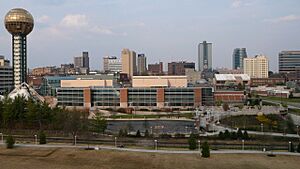
Knoxville's tallest buildings are the First Tennessee Plaza and the Riverview Tower. Both are on Gay Street. The most famous building is the Sunsphere. It is a 266-foot tall steel tower built for the 1982 World's Fair. The Tennessee Amphitheater is also a remaining structure from the fair.
Downtown Knoxville has many different building styles. These range from the old James White's Fort (1786) to the modern Knoxville Museum of Art (1990). You can see Greek Revival, Victorian, Gothic, and Art Deco styles.
Many homes in Knoxville show the city's history. The William Blount Mansion (1791) is an example of early Georgian style. Neighborhoods built in the late 1800s have Victorian and Craftsman-style houses. Newer neighborhoods have Ranch-style houses.
Knoxville is home to many buildings designed by George Franklin Barber. He was a famous Victorian architect who lived in the city.
Events in Knoxville
The Knoxville Christmas in the City event lasts for eight weeks. It includes the Singing Christmas Tree and ice skating.
- Asian Festival
- Big Ears Festival
- Boo At The Zoo
- Brewfest
- Concerts on the Square
- Dogwood Arts Festival
- Fantasy of Trees
- Festival on the Fourth
- First Friday ArtWalk
- Greek Fest
- HoLa Festival
- International Biscuit Festival
- Knox Food Fest
- Knoxville Hardcore Fest
- Knoxville Horror Film Festival
- Knoxville Marathon
- Knoxville Powerboat Classic
- Market Square Farmers' Market
- NSRA Street Rod Nationals South
- Rhythm & Blooms Festival
- Rossini Festival
- Tennessee Valley Fair
- Vestival
- Volapalooza
Places to Visit
- Beck Cultural Exchange Center
- Bijou Theatre
- Bleak House
- William Blount Mansion
- Fountain City Art Center
- Candoro Marble Works
- Civic Coliseum
- Fort Dickerson
- Haley Heritage Square
- Ijams Nature Center
- James White's Fort
- Knoxville Botanical Gardens and Arboretum
- Knoxville Convention Center
- Knoxville Greenways
- Knoxville Museum of Art
- Knoxville Police Museum
- Zoo Knoxville
- Mabry-Hazen House
- Marble Springs
- Market Square
- Frank H. McClung Museum
- Museum of East Tennessee History
- National Register of Historic Places, Knox County, Tennessee
- Old City
- Ramsey House
- Sunsphere
- Tennessee Amphitheater
- Tennessee River Boat
- Tennessee Theatre
- Three Rivers Rambler Train Ride
- Volunteer Landing
- Women's Basketball Hall of Fame
- World's Fair Park
- Knoxville's Urban Wilderness
Libraries in Knoxville
The Knox County Public Library system has the Lawson McGhee Library downtown. It also has 17 branch libraries. Together, they have over 1.3 million books and other items.
Sports in Knoxville
The University of Tennessee's sports teams are called the "Volunteers" or "the Vols." They are very popular. Neyland Stadium, where the football team plays, is one of the largest stadiums in the world. It can seat over 100,000 fans. Thompson–Boling Arena is home to the basketball teams. It is one of the largest indoor basketball arenas in the country. The phone area code for the region is 865, which spells "VOL".
Knoxville is also home to the Women's Basketball Hall of Fame. This is largely due to the success of Pat Summitt and the University of Tennessee women's basketball team.
Professional sports teams in Knoxville include:
| Team | Sport | League | Venue (Capacity) |
|---|---|---|---|
| Knoxville Ice Bears | Hockey | SPHL | Knoxville Civic Coliseum (6,500) |
| Knoxville Smokies | Baseball | Southern League (Double-A) | Covenant Health Park (7,500) |
| One Knoxville SC | Soccer | USL League One | Regal Stadium (3,000) |
Education in Knoxville
Knoxville is home to the main campus of the University of Tennessee (UTK). It has been in the city since the 1790s. In 2011, UTK had over 27,000 students. It offers more than 300 degree programs.
Pellissippi State Community College is a two-year school. It offers programs to transfer to a four-year college. Its main campus is in western Knox County.
Johnson University is a Bible college. It trains preachers and ministers. It also offers degrees in counseling and teaching.
South College offers programs in business, healthcare, and law.
Knoxville College was a historically black college. It closed permanently in 2015.
Several other universities have branch campuses in Knoxville. These include Carson-Newman University and Lincoln Memorial University.
Schools for Younger Students
Public schools in Knoxville are part of the Knox County Schools system. This system has 89 schools and serves over 56,000 students. It includes magnet schools and a STEM academy. In 2011, the high school graduation rate was 86.6%.
Knox County also has over 50 private schools. Some of the largest are the Christian Academy of Knoxville and the Webb School of Knoxville.
Media in Knoxville
The Knoxville News Sentinel is the main daily newspaper in Knoxville.
The city also has several weekly and monthly publications.
Knoxville is the 61st largest television market in the U.S. Local TV stations include WBIR-TV (NBC), WATE-TV (ABC), and WVLT-TV (CBS). East Tennessee PBS is the local Public Broadcasting Service station.
Discovery, Inc. operates several cable TV networks from Knoxville. These include HGTV, Food Network, and Cooking Channel. Jewelry Television, a shopping channel, is also based here.
Knoxville is the 72nd largest radio market in the U.S. Popular radio stations include WIVK (country music) and WJXB (adult contemporary). The University of Tennessee has its own radio station, WUTK.
Movies Filmed in Knoxville
Several movies and TV shows have been filmed in Knoxville. These include:
- October Sky (1999)
- Road Trip (2000), filmed at the University of Tennessee
- Box of Moonlight
- Scenes from The Heart Is Deceitful Above All Things (2004)
- Woman In Hiding (1949)
- The Last Movie Star (2017), starring Burt Reynolds
Getting Around Knoxville
Utilities and Services
The Knoxville Utilities Board (KUB) provides electricity, water, and wastewater services. KUB serves over 196,000 customers. It buys its electricity from the Tennessee Valley Authority.
Roads and Highways
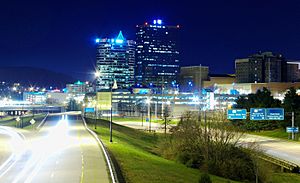
Knoxville is served by two major interstate highways: Interstate 40 and Interstate 75. I-40 connects Knoxville to Asheville and Nashville. I-75 connects it to Chattanooga and Lexington. These interstates meet west of downtown.
Interstate 640 is a bypass for I-40 travelers. Interstate 275 offers a faster route to I-75 for downtown travelers. Interstate 140 (Pellissippi Parkway) connects West Knoxville to the airport and Maryville.
Before 1982, the interchange of I-75 and I-40 was known as "Malfunction Junction" because of heavy traffic.
The busiest road in Knoxville is U.S. Route 129, also called Alcoa Highway. It connects downtown to McGhee Tyson Airport. Other important U.S. routes include US-70, US-11, and US-441. US-441 connects Knoxville to the Great Smoky Mountains National Park.
Four bridges connect Downtown Knoxville to South Knoxville over the Tennessee River. These include the Gay Street Bridge and the Henley Street Bridge.
Public Transportation
Knoxville Area Transit (KAT) provides public transportation. It operates over 80 buses and trolleys. KAT transports more than 3.6 million passengers each year. Its routes connect downtown, the University of Tennessee, and shopping centers.
Airports Serving Knoxville
Knoxville is served by McGhee Tyson Airport (IATA:TYS). It is about 10 miles south of Knoxville. The airport has two runways and serves 19 non-stop destinations. It has about 120 arrivals and departures daily. The airport also has a cargo complex for shipping companies.
The McGhee Tyson Air National Guard Base is next to the civilian airport. It is home to the Tennessee National Guard's 134th Air Refueling Wing.
The city also has the Knoxville Downtown Island Airport. This is a smaller airport for private planes.
Railroads and River Transport
Rail freight in Knoxville is handled by CSX and Norfolk Southern. There is also a smaller railroad called the Knoxville and Holston River Railroad. Railroads move a lot of goods into and out of the city.
Knoxville has two main rail terminals. The John Sevier Yard is a major sorting yard for trains.
The Knoxville and Holston River Railroad also operates the Three Rivers Rambler. This is a tourist train that runs along the riverfront.
Knoxville is an international port. It is connected by waterways to the Mississippi River and the Gulf of Mexico. Barges deliver goods like asphalt and steel to Knoxville. The city's public barge terminal handles about 350,000 tons of cargo each year.
Recreational boats also use the river. There are boat slips and a marina at Volunteer Landing. The VOL Navy is a group of boats that gather on the river during University of Tennessee football games.
Sister Cities
Knoxville has seven sister cities around the world:
 Yesan, Republic of Korea
Yesan, Republic of Korea Chełm, Lublin Voivodeship, Poland
Chełm, Lublin Voivodeship, Poland Chengdu, Sichuan, People's Republic of China
Chengdu, Sichuan, People's Republic of China Kaohsiung, Republic of China
Kaohsiung, Republic of China Larissa, Greece
Larissa, Greece Muroran, Hokkaido, Japan
Muroran, Hokkaido, Japan Neuquen, Argentina
Neuquen, Argentina
|
See also
 In Spanish: Knoxville para niños
In Spanish: Knoxville para niños





